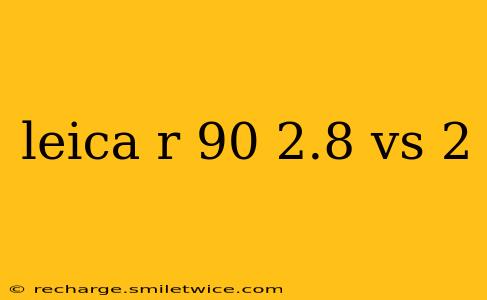Leica R 90mm f/2.8 vs f/2: A Detailed Comparison for Discerning Photographers
The Leica R 90mm lenses, available in f/2.8 and f/2 apertures, represent the pinnacle of quality and craftsmanship in medium-telephoto prime lenses. Both are exceptional performers, but subtle differences cater to specific photographic needs and preferences. This in-depth comparison will help you decide which lens is right for you.
What are the Key Differences Between the Leica R 90mm f/2.8 and f/2?
The most obvious difference lies in the aperture. The f/2 lens offers a significantly wider maximum aperture than the f/2.8 version. This seemingly small difference translates to several crucial advantages and disadvantages.
Aperture and Low Light Performance: The f/2's Wider Aperture Advantage
The Leica R 90mm f/2 boasts a full stop faster aperture. This translates to better low-light performance. You can shoot at lower ISO settings, resulting in cleaner images with less noise. This advantage is particularly significant in challenging lighting conditions, like dimly lit interiors or evening shoots. The shallower depth of field also helps isolate subjects beautifully, even in low light.
Depth of Field: Exploring the Creative Implications
The wider aperture of the f/2 lens also results in a significantly shallower depth of field. This allows for more dramatic background blur (bokeh), ideal for portraits and isolating subjects against busy backgrounds. The f/2.8, while still capable of pleasing bokeh, offers a slightly deeper depth of field, which might be preferable for situations requiring more of the scene to be in focus, like architectural photography or some landscape work.
Image Quality and Sharpness: A Tale of Two Lenses
Both lenses are renowned for their exceptional image quality and sharpness. However, some users report slightly sharper images from the f/2.8 lens at its sweet spot. This difference is often subtle and may not be noticeable in all situations. The f/2's superior light gathering capabilities, however, can often lead to more usable images in low-light situations, potentially outweighing any slight sharpness differences.
Size and Weight: A Practical Consideration
While both lenses are relatively compact for their focal length and build quality, the f/2 lens is generally slightly larger and heavier than the f/2.8. This difference can be noticeable during extended shooting sessions.
Cost: A Significant Factor
Generally, the Leica R 90mm f/2 commands a higher price than the f/2.8 version. This price difference reflects the increased complexity and engineering required to produce a faster lens.
Which Lens is Right for Me?
The "best" lens depends entirely on your individual needs and priorities.
-
Choose the Leica R 90mm f/2 if: You prioritize low-light performance, a shallower depth of field for creative blurring, and don't mind the increased size and cost. If you frequently shoot in challenging lighting conditions or need maximum background separation, this lens is a strong contender.
-
Choose the Leica R 90mm f/2.8 if: You prioritize a slightly more compact and potentially budget-friendly option, and don’t need the extreme low-light capabilities. If you shoot in well-lit conditions or need more of the scene in focus, the f/2.8 lens could be the better choice.
Ultimately, both Leica R 90mm lenses represent exceptional optical engineering. The decision comes down to weighing the advantages and disadvantages of each lens against your specific photographic style and priorities.
